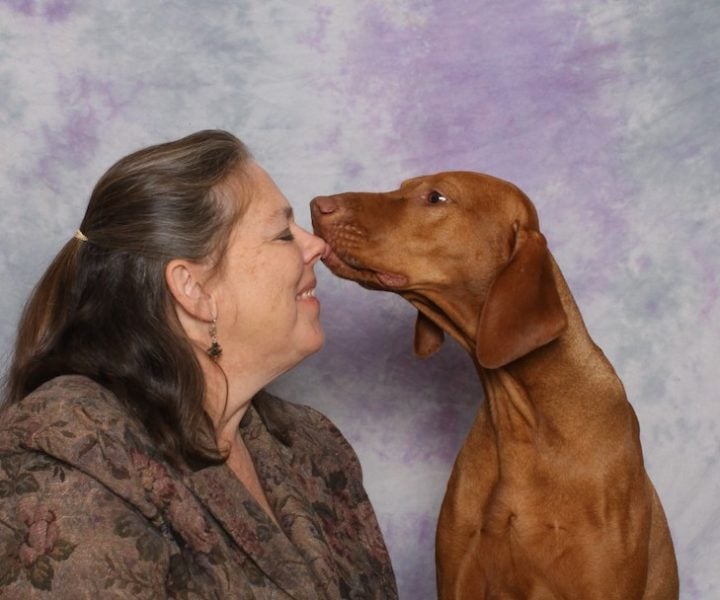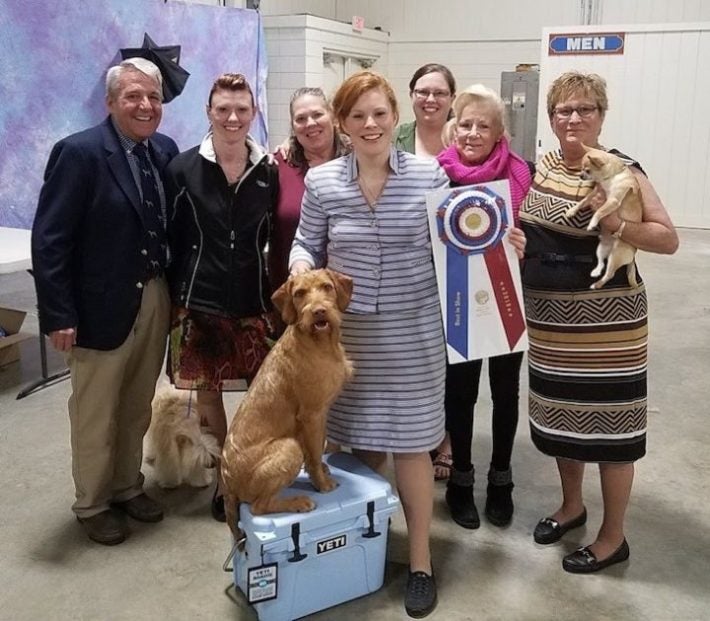
Life may be a box of chocolates, but after you’ve nibbled enough bonbons, you know which flavor you like best. Over the past four decades, Nancy Edmunds of Travelers Rest, South Carolina, has owned quite a Whitman’s Sampler of purebreds, including Cocker Spaniels, Manchester Terriers, Whippets, Brussels Griffons, Poodles, and Afghan Hounds. But in 1985, she finally came across her forever breed: the Vizsla.
After almost 30 years breeding those Hungarian hunters, her Vizcaya Vizslas kennel expanded to include Wirehaired Vizslas, and today she continues to actively breed and exhibit both breeds, whose differences extend beyond their coats.
Here, Edmunds talks about her start in the dog fancy, Vizsla myths that need debunking, and what it’s like to breed “real” dogs.
Choices, choices, choices
Of the breeds I had, there was always something that didn’t “fit” with me. When I was 19, I loved how the Afghan Hound looked – I think I was jealous of their gorgeous hair! – and I purchased one. After several years of exhibiting Afghans, I discovered I wasn’t one of those who loves to groom for hours before ring time, and some of the breeds just didn’t work with my situation and family. But to this day, I love every breed I was involved with, and often stop by the rings to watch and reminisce.
Reality strikes
After a few years of my trying to make it with one breed or another, my husband Randy asked me why I didn’t have a “real dog.” He came to a show with me, and a Vizsla walked by us. “That’s a real dog!” he said, and asked what breed it was. We purchased our first Vizsla from Soapstone Vizslas for me to show, but she was to be my husband’s dog. After living with Maggie and traveling to shows with her, I fell head over heels for the breed and their temperament.

Down to the “wire”
Way back in the dark ages of AOL “chat rooms,” I was in a dog-lovers group, and there was a woman who mentioned she had a Wirehaired Vizsla litter. I had always heard that the Wirehaired Vizsla had a difficult temperament, so I had never considered one. She let me know that her dogs were calm, sweet, quiet, and very lovable. Intrigued, I flew to meet her and her dogs, and ended up bringing a puppy home. “Remy” – BIS ARBA, UKC CH, IABCA CH BIMisc Vizland’s Vizcaya Remy Red CM – was the foundation bitch for Vizcaya Wirehaired Vizslas, and I had her until she was 15½ years old.
Vizsla myth #1
That the smooth Vizsla sheds less than the Wirehaired Vizsla. Wiry hair doesn’t fall out of the follicle as easily as silky hair.
Vizsla myth #2
That both breeds are high strung and crazy! Neither is true, in my experience. Both breeds can have energy, but not to the level some people think.
Biggest judging oops
Not reading and understanding the standards! You can’t judge the Wirehaired Vizsla as though it is a smooth Vizsla with a wire coat. They are separate breeds, and should be judged accordingly. Physically, the Wirehaired Vizsla is a larger dog, with more bone and substance.
Popular demand
Back in 1985, when I started showing smooth Vizslas, it took four dogs or bitches for a major. Now there is no problem finding points in the breed, and the number of breeders with kennel names is surprising. Back then, I feel dogs had more bone and better fronts. I am not thrilled with where much of this breed has gone in the last 35 years.
I have had Wirehaired Vizslas for 17 years, and they were just recognized by AKC in July 2014. In those five years, their popularity has certainly grown. There is good in that, but it also scares me, because I saw what happened to the smooth Vizsla over time. The Wire has not had enough time to develop a consistent type.

Savor the victory
I am always proud of wherever I am with a particular dog in its show career – first point, first major, finishing a championship or a Grand Championship. Now, there are levels of a Grand, and I am proud of those accomplishments, too, each and every time!
Proudest moment
Watching the very first Wirehaired Vizsla take a Best in Show at an AKC all-breed show. I co-own BIS GCHB Vizcaya’s Vizland Cherokee Asagi with Jim and Susan Daly, and we were ringside. Exhilaration! He is still the only BIS wire as of today. I know that will change some day, and there will be another, but he will always be the first. Many judges hesitate to put up rare breeds, much less give them a Group 1. I feel many judges think they haven’t “paid their dues” yet, which to me is ridiculous. If the dog deserves it, give it to them.
Breeding philosophy
You have to break your dogs down, really look at their faults, and only breed dogs together that can improve each other’s faults. Never introduce a fault that your dogs have never had an issue with, even when the rest of the dog is awesome. I made that mistake in smooth Vizslas a few years back, and it took me at least two generations to eliminate it. I’m not making that mistake again.
Badge of honor
I think the Breeder of Merit program shows others that you are serious, and that you have accomplished titles and quality breeding. Having reached the Gold level in smooth Vizslas and Bronze level in Wires, the most valuable thing to me is the ability to have the recognition on my AKC registration certifications and the banners for my web site.
Parting advice
Keep good records, register your puppies, keep up with your owners, and breed healthy, quality dogs!

